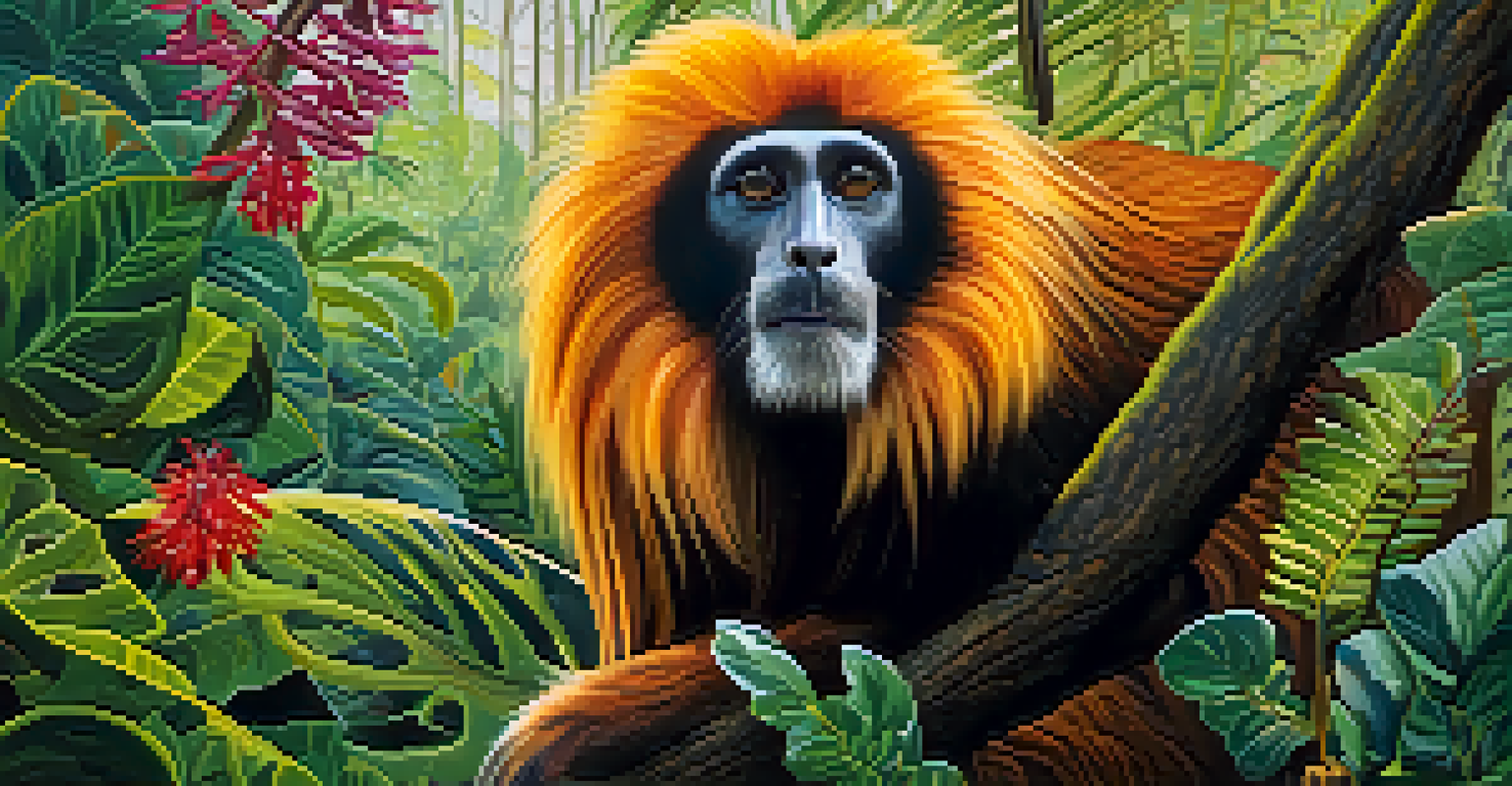Exploring the Biodiversity of Brazil's National Parks

Introduction to Brazil's National Parks and Biodiversity
Brazil is home to some of the most stunning national parks in the world, teeming with biodiversity. These parks protect a wealth of ecosystems, from lush rainforests to arid savannas, making them vital for conservation efforts. With over 70 national parks, Brazil offers a unique opportunity to explore diverse flora and fauna, many of which are found nowhere else on Earth.
The clearest way into the Universe is through a forest wilderness.
The significance of these parks goes beyond their beauty; they play a crucial role in preserving endangered species and promoting ecological balance. For instance, the Amazon Rainforest, which covers much of Brazil, is often referred to as the 'lungs of the planet' because of its capacity to produce oxygen and absorb carbon dioxide.
By exploring these parks, visitors can gain a deeper appreciation for the intricate web of life that exists within them. Whether it’s the colorful birds of Pantanal or the unique species of the Atlantic Forest, each park offers a glimpse into Brazil's rich natural heritage.
The Amazon Rainforest: A Biodiversity Hotspot
The Amazon Rainforest is undoubtedly the crown jewel of Brazil's biodiversity. Covering over 60% of the country's land area, this vast ecosystem is home to approximately 10% of all known species on the planet. From jaguars and capybaras to countless insect species, the Amazon is a vibrant tapestry of life.

One fascinating aspect of the Amazon is its sheer variety of plants and animals. For instance, researchers estimate that there are about 40,000 plant species, which are not just beautiful to look at but also vital for medicine and food. This diversity supports various wildlife, making the Amazon a crucial area for ecological research and conservation.
Brazil's Parks Preserve Biodiversity
Brazil's national parks protect diverse ecosystems vital for conservation and the survival of countless species.
However, this incredible biodiversity is under threat due to deforestation, climate change, and illegal activities. Efforts are underway to protect the Amazon, emphasizing the importance of sustainable practices and eco-tourism, which can help preserve its natural beauty while benefiting local communities.
Exploring the Pantanal: The World's Largest Wetland
The Pantanal, another UNESCO World Heritage site, is the world's largest tropical wetland, boasting an astonishing array of wildlife. Spanning over 75,000 square miles, it’s a paradise for birdwatchers and nature enthusiasts alike. Here, you can spot caimans, capybaras, and even the elusive jaguar lurking in the underbrush.
In every walk with nature, one receives far more than he seeks.
What makes the Pantanal truly remarkable is its seasonal flooding, which creates a dynamic ecosystem that supports a rich diversity of species. During the rainy season, the landscape transforms, attracting migratory birds and creating ideal conditions for fish breeding. This cyclical pattern of flooding and drying supports life in a way that few other environments can.
Visitors to the Pantanal often leave with unforgettable memories, whether it's witnessing a glorious sunset over the wetlands or encountering wildlife up close. Eco-tours and guided safaris provide opportunities to learn about the delicate balance of this ecosystem and the importance of preserving it for future generations.
The Atlantic Forest: A Unique Ecosystem at Risk
The Atlantic Forest once stretched along Brazil's southeastern coast, but today, only a fraction remains, making it one of the most endangered ecosystems in the world. Despite its size reduction, this forest is still rich in biodiversity, hosting thousands of plant and animal species, many of which are endemic.
One of the forest's standout features is its incredible variety of trees, some of which grow to be over a hundred feet tall. This diversity provides essential habitats for various species, including the endangered golden lion tamarin, which relies on this forest for its survival. Protecting this unique ecosystem is crucial for maintaining the delicate balance of nature.
Amazon Rainforest Faces Threats
The Amazon, hosting 10% of Earth's species, is under threat from deforestation and climate change, emphasizing the need for sustainable practices.
Conservation efforts are now more important than ever. By visiting parks like Tijuca National Park in Rio de Janeiro, travelers can support these initiatives while enjoying the breathtaking beauty of the Atlantic Forest. Engaging in eco-tourism helps raise awareness and funds for preservation efforts, ensuring that this vibrant ecosystem can thrive for years to come.
The Role of National Parks in Conservation
National parks serve as vital sanctuaries for wildlife and plants, providing protected areas where ecosystems can thrive without human interference. These parks not only preserve biodiversity but also help maintain essential ecological processes, such as pollination, seed dispersal, and nutrient cycling. By safeguarding these natural habitats, we ensure a balanced environment for future generations.
Conservation efforts within these parks often include scientific research and monitoring, which are crucial for understanding the needs of various species and ecosystems. For example, biologists regularly study animal populations and plant health to develop effective management strategies. This research helps to inform policies that protect both the parks and the surrounding communities.
Moreover, national parks serve as a crucial tool for education and awareness. They inspire visitors to appreciate nature's beauty and understand the importance of biodiversity. When people connect with these environments, they are more likely to support conservation initiatives and advocate for sustainable practices in their own lives.
Challenges Facing Brazil's National Parks
Despite their importance, Brazil's national parks face numerous challenges that threaten their integrity. Deforestation, illegal logging, and agricultural expansion are significant issues that encroach on these protected areas. These activities not only endanger wildlife but also disrupt the ecological balance that national parks strive to maintain.
Climate change also poses a substantial threat, impacting weather patterns and altering habitats. As temperatures rise and precipitation becomes more erratic, species may struggle to adapt, leading to a decline in biodiversity. For instance, certain plants may not survive changing conditions, which can have a cascading effect on the entire ecosystem.
Responsible Eco-Tourism is Key
Engaging in responsible eco-tourism helps support conservation efforts while promoting awareness of Brazil's unique biodiversity.
Effective management and policy enforcement are crucial in addressing these challenges. By increasing awareness and promoting sustainable practices, we can help protect these natural treasures. Collaboration between governments, NGOs, and local communities is vital to ensure that Brazil's national parks continue to thrive amid growing pressures.
How to Experience Brazil's Biodiversity Responsibly
Visiting Brazil's national parks offers a unique opportunity to experience biodiversity firsthand while contributing to conservation efforts. To ensure responsible tourism, it's essential to choose eco-friendly tours and accommodations that prioritize sustainability. This way, your visit can have a positive impact on the local environment and economy.
When exploring these parks, follow established trails and guidelines to minimize your impact on delicate ecosystems. Respect wildlife by observing from a distance and avoiding feeding or disturbing animals. Engaging with knowledgeable guides can enhance your experience, providing insights into the park's unique flora and fauna while ensuring you adhere to responsible practices.

Lastly, consider supporting local communities through your travel choices. Purchasing handmade crafts or participating in community-led initiatives not only enriches your experience but also empowers locals to protect their environment. By being a conscious traveler, you can help preserve the incredible biodiversity of Brazil's national parks for future generations.